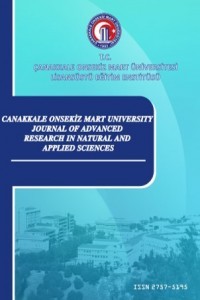Using Granular Waste Tire as a Factor to Increase Shear Strength of Cohesionless Soils
Shear strength, scrap tire sand, soil,
___
- Aktürk, K. (2018). Lastik parçacıklarının kumlu zeminlerin kayma dayanımına etkisi. (Yayımlanma-mış Yüksek Lisans Tezi). Çanakkale Onsekiz Mart Üniversitesi, Çanakkale, Türkiye.
- Attom, M. F. (2006). The use of shredded waste tires to improve the geotechnical engineering properties of sands. Environmental Geology, 49(4), 497-503.
- Balaban, E., Smejda, A. & Onur, M. I. (2019). Influence of tire crumbs on mechanical properties of sand-fine soil mixtures. Geomechanics and Geoengineering, 1-16.
- Bayat, O., Askarani, K. K. & Hajiannia, A. (2019). Effects of waste tire on the shear strength of sand. International Journal of Structural and Civil Engineering Research.
- Benavente-Huaman, E., Navarro-Cardenas, M. ve Duran-Ramirez, G. (2019). Strength behaviour of shredded rubber silty sand mixtures. In 2019 7th International Engineering, Sciences and Technology.
- Cetin, H., Fener, M. & Gunaydin, O. (2006). Geotechnical properties of tire-cohesive clayey soil mixtures as a fill material. Engineering Geology, 88(1-2), 110-120.
- Chang N. B. (2008). Economic and policy instrument analyses in support of the scrap tire recycling program in Taiwan. Journal of Environmental Management, 86, 435–450.
- Çataklı, T. & Ergüder, T. H. (2019). Biyodevulkanizasyon: Atık lastik yönetiminde çevre dostu bir yaklaşım. Ulusal Çevre Bilimleri Araştırma Dergisi, 2(1), 20-34.
- Edil, T. B. & Bosscher, P. J. (1994). Engineering properties of tire chips and soil mixtures. Geotechnical testing journal, 17(4), 453-464.
- Erenson, C. (2015). Atık lastiklerin taş/kum kolon uygulamalarında kullanılmasının deneysel olarak incelenmesi. Yüksek Lisans Tezi.
- Eryılmaz, H. & Demirarslan, K. O. (2019). Ömrünü tamamlamış lastiklerin (ötl) sıvılaştırılarak geri dönüşümünün araştırılması. Sürdürülebilir Mühendislik Uygulamaları ve Teknolojik Gelişmeler Dergisi, 2(1), 50-56.
- Foose, G. J., Benson, C. H. & Bosscher, P. J. (1996). Sand reinforced with shredded waste tires. Journal of Geotechnical Engineering, 122(9), 760-767.
- Ghaffari, J. (2020). Triaxial determination of shear strength of tire chips-sand-geotextile mixtures. AUT Journal of Civil Engineering.
- Ghazavi, M. (2004). Shear strength characteristics of sand-mixed with granular rubber. Geotechnical and Geological Engineering, 22(3), 401-416.
- Göztepe B., (2016). Experimental study on mitigation of earthquake hazards using rubber-soil mixture. Yüksek Lisans Tezi.
- Hataf, N. & Rahimi, M. M. (2006). Experimental investigation of bearing capacity of sand reinforced with randomly distributed tire shreds. Construction and Building Materials, 20(10), 910-916.
- Humphrey, D. N., Katz, L. E. & Blumenthal, M. (1997). Water quality effects of tire chip fills placed above the groundwater table. Testing soil mixed with waste or recycled materials. ASTM International.
- Humphrey, D. N. & Lynn, E. K. (2000). Five year study of the water quality effects of tire shreds placed above the water table. Transportation Research Board: Washington, DC.
- Humphrey, D. N. & Swett, M. (2006). Literature review of the water quality effects of tire derived aggregate and rubber modified asphalt pavement. Report for US EPA.
- Keskin M. S. & Laman M. (2012). Atık lastik-kum karışımlarının kayma mukavemetinin laboratuar deneyleriyle incelenmesi. Çukurova Üniversitesi Mühendislik-Mimarlık Fakültesi Dergisi, 27 (2): 27-36.
- Marto A., Latifi N., Moradi R., Oghabi M. & Zolfeghari S. Y. (2013). Shear properties of sand-tire chips mixtures. Electronic Journal of Geotechnical Engineering, 18: 325-334.
- Mashiri, M. S., Vinod, J. S., Sheikh, M. N. & Tsang, H. H. (2015). Shear strength and dilatancy behavior of sand–tyre chip mixtures. Soils and Foundations, 55(3), 517-528.
- Ordu E., Biçer P., Ordu S. & Abanozoğlu E. G. (2017). An investigation on the soil stabilization with waste tyres materials in granular soils. Aksaray University Journal of Science and Engineering, 1(1), 51-61.
- Özaydın K. (2011). Zemin Mekaniği. Birsen Yayınevi, İstanbul, Türkiye. 350 s.
- Reddy, K. R. & Marella, A. (2001). Properties of different size scrap tire shreds: implications on using as drainage material in landfill cover systems. The Seventeenth International Conference on Solid Waste Technology and Management, Philadelphia, USA, 1-19.
- Seed, H. B. & Idriss, I. M. (1971). Simplified procedure for evaluating soil liquefaction potential. Journal of Soil Mechanics and Foundations Division.
- Sheikh, M. N., Mashiri, M. S., Vinod, J. S. & Tsang, H. H. (2013). Shear and compressibility behavior of sand–tire crumb mixtures. Journal of Materials in Civil Engineering, 25(10), 1366-1374.
- Şengezer, L. (2010). Granüler zeminlerde dinamik kompaksiyon uygulaması. Doktora Tezi.
- Tatlisoz N., Edil T. B. & Benson C. H., 1998. Interaction between reinforcing geosynthetics and soil-tire chip mixtures. Journal of Geotechnical and Geoenvironmental Engineering, 124 (11): 1109-1119.
- Tsang, H. H., Lo, S. H., Xu, X. & Sheikh, M. N. (2012). Seismic isolation for low‐to‐medium‐rise buildings using granulated rubber–soil mixtures: numerical study. Earthquake engineering and structural dynamics, 41(14), 2009-2024.
- Umu S. U., Okur D. V., Yılmaz G. & Fırat S., 2014. Dinamik yükleme şartlarında kum/lastik karışımla-rının rijitlik ve sönüm özelliklerinin incelenmesi. Politeknik Dergisi, 17 (1):13-21.
- Vinod, J. S., Sheikh, M. N., Mastello, D., Indraratna, B. & Mashiri, M. S. (2015). The direct shear strength of sand-tyre shred mixtures. Proceedings of the International Conference on Geotechnical Engineering, (pp. 193-196). Youwai, S. & Bergado, D. T. (2003). Strength and deformation characteristics of shredded rubber tire sand mixtures. Canadian Geotechnical Journal, 40(2), 254-264.
- Zornberg J. G., Cabral A. R. & Viratjandr C. (2004). Behaviour of tire shred sand mixtures. Canadian Geotechnical Journal, 41 (2): 227-241.
- url1: https://atiksahasi.com/Omrunu-Tamamlamis-Lastikler, Retrieved date: 15.11.2020
- Yayın Aralığı: Yılda 4 Sayı
- Başlangıç: 2015
- Yayıncı: Çanakkale Onsekiz Mart Üniversitesi
Sünek Betonarme Perde Duvarların Şekil değiştirme Esaslı Hasar Sınırları
Saeid FOROUGHİ, Bahadır YÜKSEL
Harun ÇİFTÇİ, Çiğdem ER ÇALIŞKAN, Kübra ÖZTÜRK
Formula Student Race Car Chassis Design and Analysis
Yiğit Alp OYMAK, Erol FEYZULLAHOĞLU
Orkun DALYAN, Nuray ÖZKAYA, Mehmet PİŞKİN, Ömer Faruk ÖZTÜRK
Ali UÇAR, Sevgi KARACA, Nezahat EDİZ, Oktay ŞAHBAZ, İsmail Göktay EDİZ
